Titanosaur Locomotion

A conservative limb skeleton?
Sauropods are the largest animals to have walked on land, and many limb specializations that characterize sauropods appear to be related to trunk support and locomotion. All sauropods have four columnar limbs in which all weight-bearing elements are straight-shafted, all sauropod limb bones are capped in a thick layer or articular cartilage, and sauropods have the limb proportions of graviportal animals. Perhaps due to the constraints of large body size, the sauropod limb skeleton appears to be less variable than other parts of the skeleton. As shown in the figure above, for example, femora of different sauropod genera resemble one another closely whereas numerous anatomical features differentiate the dorsal vertebrae (e.g., neural spine length and bifurcation, lamination patterns, centrum shape). This observation has led to the notion that sauropods had a similarly restricted locomotor repertoire. Like elephants, sauropods would have maintained a limb in contact with the substrate at all times and would have maintained a straight limb posture during the stance phase of locomotion.
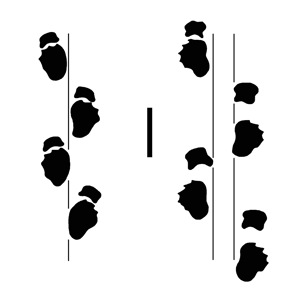
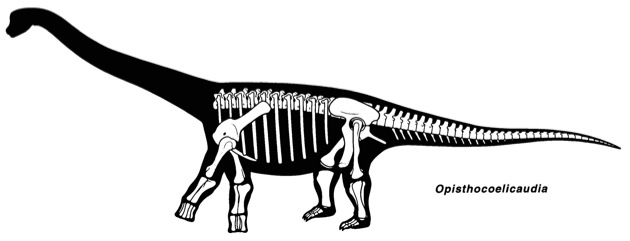
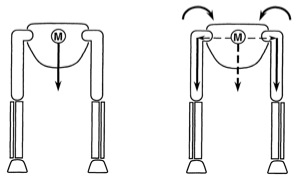
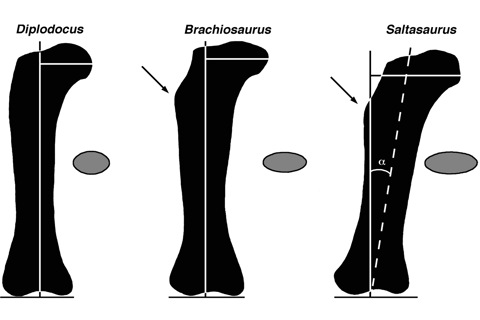
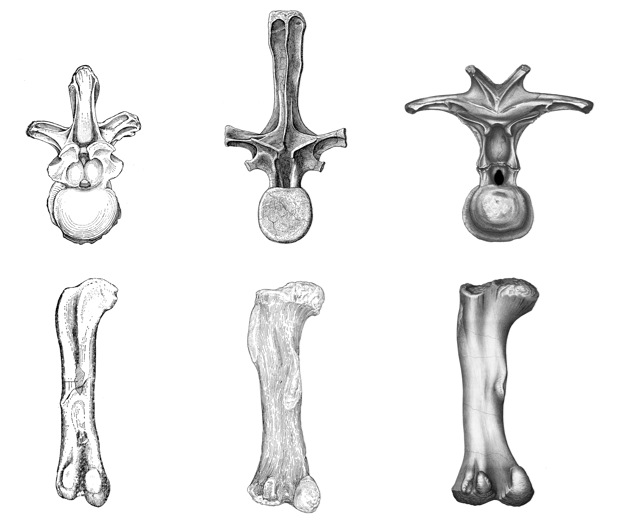
Dorsal vertebrae (anterior view) and left femora (posterior view) from three sauropod dinosaurs. Vertebrae appear vary more than limb bones in sauropods, a pattern that has been interpreted as a result of mechanical constraints on the limb bones. The femora scaled to same length, and dorsal vertebrae are scaled to centrum height. Images were taken from He et al. 1998; Gilmore 1936; Upchurch et al. 2005; and Ostrom and McIntosh 1966.
Apatosaurus
Omeisaurus
Camarasaurus
Wide-gauge trackways
Somewhat surprisingly, sauropod footprints tell a different story. Trackways are evidence of an animal in life and as such give us direct evidence of fossil behavior, once the trackmaker is identified. Sauropod trackway specialists have long recognized two types of trackways, which Farlow (1992) dubbed “narrow-gauge” and “wide-gauge” based on the position of their manus and pes relative to the trackway midline. Wilson and Carrano (1999) concluded that gauge disparity was a taxonomic feature of sauropods and used anatomical and biomechanical features to identify titanosaurs as wide-gauge trackmakers. The supporting limbs of a wide-gauge would have experienced larger bending moments than a narrow-gauge trackmaker due to their increased distance from the center of mass (see below).
The increased bending moment implied by wide-gauge locomotion would have resulted in predictable changes in the supporting limb bones. All titanosaurs have femoral shafts that are transversely elongate and anteroposteriorly compressed. This eccentric cross-section would have been better at resisting bending loads than other sauropod femora (see below). In addition to cross-sectional geometry, titanosaur femora differ from those of other sauropods in other respects, as shown in the illustration below.
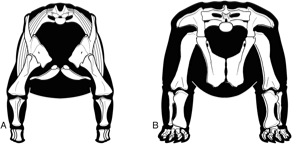
Narrow (left) and wide-gauge (right) sauropod trackways. Anterior is toward the top in both; m = manus, p = pes (from Wilson & Carrano 1999).
m
p
Schematic reconstruction of forces imposed by the center of mass (M) on parasagittal limbs. Both compression and bending moments are experienced by the supporting limbs (from Wilson & Carrano 1999).
In all titanosauriforms, the proximal one-third of the femur is deflected medially, creating a ‘bulge’ on the lateral surface of the shaft (below, arrows). Derived titanosaurs, in turn, have offset distal femoral condyles that serve to direct of shaft of the femur medially (right). These two features would have contributed to deviating the hindlimb away from the body, which is important for wide-gauge locomotion.
Titanosaur locomotion
Although there is good evidence that titanosaurs made wide-gauge trackmakers, many important questions remain:
-
•were outgroups to titanosaurs (e.g., brachiosaurids) capable of wide-gauge locomotion?
-
•what advantages did wide-gauge trackmakers have over narrow-gauge trackmakers?
-
•how did wide-gauge locomotion evolve?
-
•what feeding morphology is associated with wide-gauge locomotion?
Wilson & Carrano (1999) suggested the stable base provided by wide-gauge posture and features allowed titanosaur to rear up on their hindlimbs more readily than did other sauropods. The ability to rear or to assume a tripodal posture (using the tail as a third prop) may have afforded sauropods access to different resources than other sauropods, but it is not yet known what herbivorous changes are related to acquisition of wide-gauge posture.
Silhouette reconstruction of the wide-gauge sauropod Opisthocoelicaudia skarzynskii, with cross sections through the pectoral girdle (A) and pelvic girdle (B). From Wilson & Sereno (1998) and Wilson (2005).
Femora of three sauropod genera showing features related to wide-gauge limb posture. Titanosauriforms (e.g., Brachiosaurus, Saltasaurus) have medially deflected proximal femoral shafts (arrows); titanosaurs (e.g., Saltasaurus) have an eccentric midshaft cross-section and distal condyles that are beveled relative to the long axis of the shaft (α). From Wilson & Carrano (1999).
